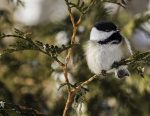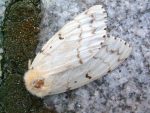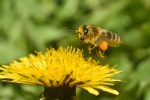Submitted by Lynn Lavoie
 Last month, Sean James’ excellent Zoom presentation on “Blooms for Birds, Bees and Butterflies” identified the benefit to biodiversity by replacing non-native invasive plants in our gardens with natives. Invasive plants reduce populations of native plants and the insects that depend on them, permanently altering ecosystems.
Last month, Sean James’ excellent Zoom presentation on “Blooms for Birds, Bees and Butterflies” identified the benefit to biodiversity by replacing non-native invasive plants in our gardens with natives. Invasive plants reduce populations of native plants and the insects that depend on them, permanently altering ecosystems.
When our gardens are filled with non-native plants, we have fewer insects and fewer birds that rely on them for food. So add some native plants to your garden to support our native wildlife at all stages of life, and transform your garden into a beautiful, dynamic space! There’s a very informative online pamphlet titled “Grow Me instead” which every gardener should read before selecting their plants.
The site can be found at:
https://www.ontarioinvasiveplants.ca/wp-content/uploads/2020/04/Southern-Grow-Me-Instead-1.pdf
It’s worth taking a few minutes to read and if you replace only one invasive garden plant, it’s a step in the right direction! Sean James supplied a comprehensive list of native plant vendors. Many local nurseries also stock a number of native species.
Nurseries / Native Seed Sources
Grow Wild! http://grow-wild.com near Omemee
North American Native Plant Society annual plant sale (in Markham this year) www.nanps.org
Ontario Native Plants https://www.onplants.ca/ – Mail Order
Not So Hollow Farm http://www.notsohollowfarm.ca/
Eden in Season: http://www.edeninseason.ca/
Fiddlehead Nursery: http://fiddleheadnursery.ca/
General Seed Company https://www.generalseedcompany.ca/
Native plants in Clairmont http://www.nativeplants.ca/
St. Williams Nursery http://stwilliamsnursery.com
Hawthorn Farm: https://hawthornfarm.ca/ (focusing on organic open-pollinated seeds)
North American Native Plant Society annual plant sale www.nanps.org
Verbinnen’s Nursery: www.verbinnens.com wholesale nursery, in Dundas
Earthgen http://www.earthgen.ca/ Dunville, ON
Stay Vigilant for Invasive Species this Season!

Spongy Moth – Last year, many of us saw the devastating effects of the recently renamed spongy moth upon our trees. Lymantria dispar dispar, formerly known as the gypsy moth, is an invasive species which, during severe outbreaks, can completely defoliate trees and shrubs over large areas. Despite the trees’ ability to produce a new crop of leaves over the summer, the damage causes substantial growth loss and susceptibility to secondary pests and drought.
According to the Ontario government’s website, in 2021 the Peterborough District had the largest area of moderate to severe defoliation of 374,268 hectares, an increase from 159,578 hectares in 2020.
Spongy-looking egg masses can be observed on the trunks and branches of infected trees. In spring, the eggs hatch and caterpillars ascend the trees and feed on the foliage. Mature caterpillars are 5 cm long, dark coloured, hairy, with a double row of five pairs of blue spots, followed by a double row of six pairs of red spots, down the back.
Control methods depend on the moth’s life stage and an excellent guide to identification and control can be found at: https://www.ontario.ca/page/lymantria-dispar-dispar-ldd-moth
 Jumping Worms – Invasive jumping worms are something to look out for this spring and summer. This group of invasive species is native to Asia and has recently popped up in Ontario. They are so named because they thrash around violently when they are disturbed. A key way to identify jumping worms is their clitellum is lighter coloured than a regular earthworm, closer to the head, and goes all the way around the worm’s body.
Jumping Worms – Invasive jumping worms are something to look out for this spring and summer. This group of invasive species is native to Asia and has recently popped up in Ontario. They are so named because they thrash around violently when they are disturbed. A key way to identify jumping worms is their clitellum is lighter coloured than a regular earthworm, closer to the head, and goes all the way around the worm’s body.
Jumping worms are destructive in forested areas. The worms chew on the leaf litter layer, breaking it down rapidly which can decrease a plant’s ability to tolerate drought. They also consume the top layer of organic material in soil — nature’s compost — which can negatively impact native plants and make the soil more susceptible to erosion. Currently there is nothing that can be done once they arrive. They are difficult to stop … so it is up to us to slow their spread!
Don’t buy or move soil, mulch, compost, nursery stock or potting mixtures from areas with established jumping worm infestations. If you discover jumping worms in horticultural material such as soil, dispose of the contaminated material in a plastic bag, which can be left out in the sun or frozen to kill any jumping worms it may contain. The most humane method to euthanize jumping worms is using isopropyl alcohol, which will kill them within seconds.
If you see jumping worms report the sighting to:
 Dandelions – a Butterfly (and Bee) Foodbank!
Dandelions – a Butterfly (and Bee) Foodbank!
One very good reason not to spray the dandelions in your garden is the fact that they are an important source of nectar for several butterfly (and bees) species including Spring Azure, Red Admiral , Painted Lady, Satyr Comma and Woodland Skipper. To help the butterfly population, dandelions can be removed after flowering and before seed dispersal.
Another way to help butterflies is to provide a mud puddle near an outdoor tap or a large dish or saucer with mud and water. Butterflies can’t get all their required nutrients from nectar. They find muddy areas to drink water and suck up salts and minerals. Try giving them a dish of lightly salted water with a sponge in it to land on; sea salt is best because it contains additional micronutrients. Butterflies like rotting fruit so don’t throw away that overripe apple or banana, peel it, set it outside and make a butterfly happy!
Happy Gardening!!
